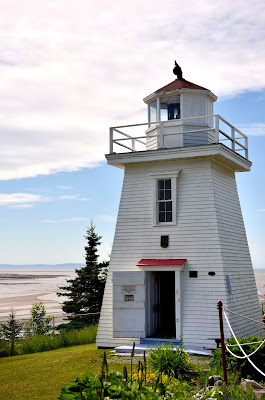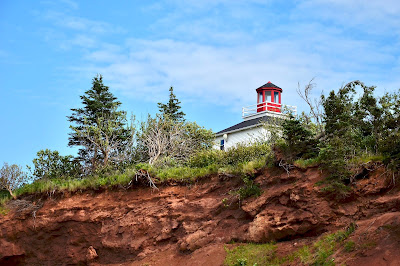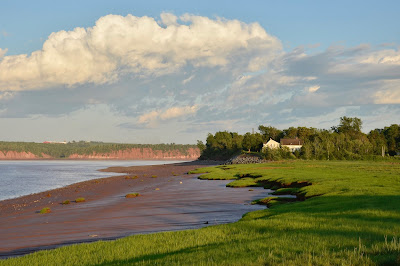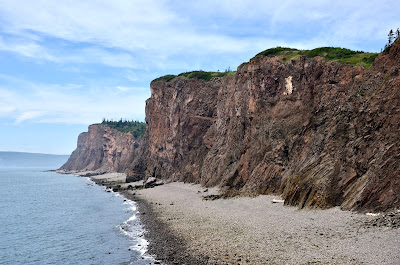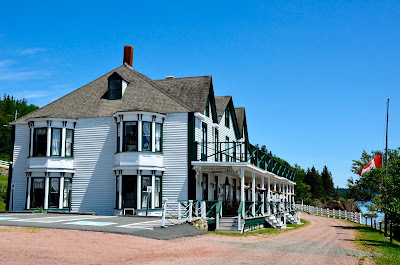Our second camper road trip this summer took us to the other side of the Nova Scotia, where we explored the Fundy coast from Windsor to Advocate Harbour. It's a part of the province we hadn't visited in decades so we were curious to see what had changed since we'd last been there.
Our first stop was in Cheverie, where we paused to have lunch and visit a camera obscura we'd heard about. The camera was built by Dalhousie Architecture students nearly a decade ago and is still in good condition. You can can read more about how and why it was built here. There are trails behind the site but we were on a mission to reach Burntcoat Head while the tide was low so didn't take time to explore them.
Our next stop was Walton, where we couldn't resist a brief detour to check out the lighthouse and learn a little history of the area. Walton may be a tiny place now but it has an impressive mining, shipbuilding and transportation past that's well worth taking some time to learn about.
After that, we were off to Burntcoat Head Provincial Park. I'd been wanting to visit for some time, and we arrived in plenty of time to explore the ocean floor. The tides at Burntcoat Head are some of the highest and fastest in the world, so staff are stationed beside the stairs leading to the beach to ensure visitors know what time they need to hightail it to higher ground to be out of harm's way.
The force of the water rising and falling so quickly has made for some truly remarkable coastline along this part of the Fundy.
By the time we left the park, we needed to start looking for a spot to camp for the night. There weren't a lot of options. All the campgrounds along the way were fully booked so we paused in a parking lot next to the Lawrence House Museum in Maitland to cook and eat supper.
The museum was closed and the parking lot had a terrific view so we'd have liked to spend the night there but signs warned us overnight parking wasn't permitted so we headed a little further up the road and found a less picturesque but quiet spot beside what looked to be a seldom used public tennis court.
Before sunset, we took in views from a newly refurbished public pier nearby and wandered into the village to marvel at the beautiful old buildings at its core. Most were in need of significant repair but it was still easy to tell Maitland had been a prosperous place at one time.
Our sleep that night would have been peaceful if we hadn't made the mistake of parking next to a marsh. We didn't realize the camper wasn't totally mosquito-proof so spent a good part of the night chasing and killing dozens of the little blighters.
From Maitland, we made a beeline for the far shore, by-passing the regional hub of Truro. Our first stop after Truro was Great Village, where we found a spot near the river to have lunch and walk Jackie. Then it was off to Bass River and the Dominion Chair General Store, where we purchased duct tape to seal a couple of small holes in our ceiling vents, which is where the mosquitos had gained entry.
When we last visited Bass Village 25 or more years ago, Dominion Chair Company was in full operation and a go-to place for folks wanting to purchase high quality tables and chairs. Those days are over, but the general store is still a fun place to explore if you're in the area.
From Bass River, we continued along the coast to Economy, where we stopped at the Cliffs of Fundy Geosite Welcome Centre to pick up maps and information about the geological significance of the Fundy coastline. We only had time to visit a view of the designated sites comprising the geopark, but look forward to exploring more of them on our next trip.
Our base while we visited the area was Five Islands Provincial Park - a beautiful and well-maintained campground with fantastic views. Our first night - a Tuesday - was spent on a site near the top of the park, where we were mostly surrounded by trees and had only limited views, but we were lucky enough to snag a site with more impressive views for our remaining nights, when folks in a tent trailer checked out early to avoid getting caught in the rain. Fortunately, the skies stayed clear for most of our next two days on the site - though it was raining hard by the time we headed home on Friday.
Wednesday morning, we were up early and headed for Cape d'Or, which I'd been wanting to visit since seeing friends' photos of the place. It didn't disappoint. The road to the parking area situated high above the lighthouse was a bit of adventure at times but well worth it. We hiked down to the lighthouse and spent an hour or more exploring, with mostly just seagulls for company.
In normal years, the cottages behind the lighthouse house a restaurant and AirBnB but, due to covid-19 restrictions, neither was operational while we were there.
After hiking back up to the parking area, we ate lunch overlooking the Fundy, then explored a trail along the top of the cliff, before heading into Advocate Harbour for a quick look around.
There's a wonderful restaurant in Advocate Harbour called Wild Caraway, where we hoped to have a meal, but unfortunately it wasn't open the day we were there. It's on our list for next time.
En route back to Five Islands, we stumbled on at a place I'd never heard of, Spencer's Island - a tiny community that was home to a substantial shipyard a generation or two ago. There's not much there now but a small cluster of mostly seasonal homes, a private campground perched where the shipyard used to operate, and a large stoney beach perfect for walking. Apparently, those familiar with NS's sailing past know it as the birthplace of the Mary Celeste, a ship with a tragic and spooky history. A marker beside the water outlines her story.
 |
| There are a few public parking spots just beside the beach |
We arrived back at our campsite in time to take in a fabulous sunset before tucking in for the night. I took a lot of photos that evening but these are two of my favourites.
Thursday morning, we were up early to drive into Parrsboro, where we ate breakfast by the beach then headed out to explore various sites of interest nearby.
 |
| A morning view from our campsite |
Our first stop was Ottawa House Museum. The house has a long and storied history but it's best known as the summer home of a former Prime Minister, Sir Charles Tupper - quite a fascinating character, as it turns out. The museum, operated by the local historical society, is jam-packed with fascinating (if somewhat chaotically displayed) artifacts and memorabilia so we enjoyed spending an hour or so exploring it.
 |
The parking lot at the museum had awesome views too!
Too bad overnight parking was prohibited. |
Just up the beach from Ottawa House is Partridge Island, a site of particular geological and historical significance for local indigenous and settler communities. An eco hiking trail up and across the Island offered some spectacular views, as well as an introduction to the island's history.
As we hiked the beach towards Patridge Island, we were fortunate to witness Glooscap's grandmother's cooking pot in action. Apparently, as the tide comes in, air trapped in porous rocks beneath the water's surface is released to create a long strip of what looks like boiling water along the beach.
After our hike, we drove a little further down the shore to the Fundy Ocean Research Centre for Energy (FORCE), where we stopped for a bite of lunch, then visited the centre's permanent exhibits, which provide an overview of efforts to develop tidal energy technologies that are robust enough to operate reliably in the fierce waters of the Bay of Fundy. Storm clouds were beginning to form by then, which made for some dramatic views from the centre's grounds.
 |
| Cape Split, shot with my long lens |
We made it back to Five Islands just before dusk. With a major storm approaching, we realized it was likely our last opportunity to visit Lighthouse Park. Undeterred by thick clouds of mosquitos, Husband took Jackie for a last walk while I madly attempted to capture a few shots of the amazing light
 |
| Clam diggers working quickly ahead of the storm |
Back at our campsite, we savoured one last sunset over the bay before tucking in for the night.
As I've already mentioned, it was raining hard by the time we hit the road for home Friday morning so we only stopped briefly a couple of times and I didn't bother trying to take photos.
I hope we'll return to the Fundy again soon. There's lots worth seeing that we didn't have time for on this trip, and we'd love to explore more of the geo-sites that make the area so unique.


